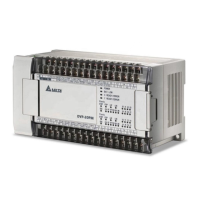11 CANopen Communication Card
CR#n78: Profile position settings
[Description]
The control register is used to set a profile position mode. A profile position mode can be absolute
positioning or relative positioning.
0: Positioning is completed.
1: A profile position mode is absolute positioning. The value in the control register will be cleared to
0 after positioning is completed.
2: A profile position mode is relative positioning. The value in the control register will be cleared to 0
after positioning is completed.
3: A profile position mode is absolute positioning. The value in the control register will be retained
after positioning is completed.
CR#n80: Homing method
[Description]
The control register is used to set a homing method.
Range: 1~35
For more information, please refer to chapter 13 in CiA DSP402 V2.0.
CR#n81~CR#n82: Home offset
[Description]
The control registers are used to set a home offset.
Range: -2,147,483,648~2,147,483,647
Data type: Double word
CR#n83~CR#n84: Homing speed
[Description]
The control registers are used to set a homing speed.
Range: 0~2,147,483,647
Data type: Double word
CR#n85~CR#n86: Speed at which motion homes after a transition in a DOG signal
[Description]
The control registers are used to set the speed at which motion homes after a transition in a DOG signal.
Range: 0~2,147,483,647
Data type: Double word
CR#n87~CR#n88: Homing acceleration time
[Description]
The control registers are used to set homing acceleration time.
Range: 0~2,147,483,647
Data type: Double word
CR#n89: Enabling a homing mode
[Description]
A homing mode will be executed if the value in the control register is 1. After homing is completed, the
value in the control register will be cleared to 0 automatically.
DVP-20PM Application Manual
11-14

